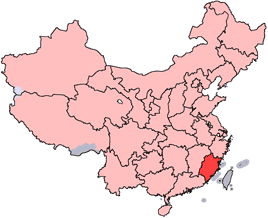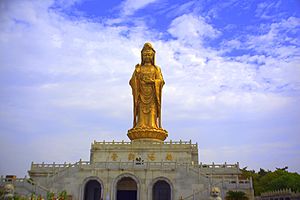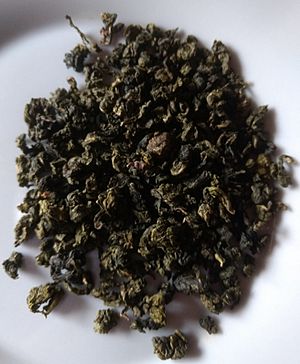Tieguanyin facts for kids
 |
|
| Type: | Oolong |
|
|
|
| Other names: | Iron Goddess, Iron Guanyin, Ti Kuan Yin, Tiet Kwun Yum |
| Origin: | Anxi County, Fujian, China and others |
|
|
|
| Quick description: | The harvests in spring (also known as Jade) and autumn are most prized for the fruity, sometimes even berry taste and aroma |
|
|
|
| Temperature: | 90–95 °C (194–203 °F) |
Tieguanyin (pronounced tee-eh-gwahn-yin) is a special kind of oolong tea from China. It started in the 1800s in a place called Anxi in Fujian province. This tea is famous for its unique taste and smell, which can be different depending on where in Anxi it's grown.
Contents
What's in a Name?

Tieguanyin is grown in Fujian province, China
|
The tea gets its name from a Chinese goddess called Guanyin. She is known as the Goddess of Mercy or Compassion. People in Japan call her Kannon, in Korea she is Gwan-eum, and in Vietnam, she is Quan Âm.
You might also hear Tieguanyin called "Ti Kuan Yin," "Iron Buddha," or "Iron Goddess Oolong." Sometimes, people just call it "TGY" for short.
Cool Legends About the Tea
There are two main stories about how Tieguanyin tea was discovered. They are called the Wei legend and the Wang legend.
The Wei Legend
In Anxi County, there was an old temple with an iron statue of Guanyin. A poor farmer named Wei walked past it every day. He felt sad seeing the temple fall apart.
Wei didn't have money to fix the temple. So, he decided to do what he could. He brought a broom and incense from his home. He swept the temple clean and lit the incense for Guanyin. He did this twice a month for many months.
One night, Guanyin appeared to Wei in a dream. She told him about a secret cave behind the temple. Inside, he would find a treasure to share with others. In the cave, Wei found a small tea plant.
He planted the tea shoot in his field and took good care of it. It grew into a big bush that made the best tea. Wei shared parts of this special plant with all his neighbors. He started selling the tea and called it Tieguanyin, meaning "Iron Bodhisattva of Compassion."
Soon, Wei and his neighbors became successful. The old temple was fixed and became a bright spot in the area. Wei was always happy on his way to the tea fields, stopping to admire the beautiful temple.
The Wang Legend
Wang was a smart scholar who found a tea plant by accident. He saw it growing under a rock called Guanyin Rock in a place called Xiping. He took the plant home and grew it.
Later, Wang visited the Qianlong Emperor. This was in the sixth year of the emperor's rule. Wang gave the emperor some of the tea as a gift from his village. The emperor loved the tea very much. He asked where it came from. Since it was found under Guanyin Rock, the emperor decided to name it Guanyin tea.
How Tieguanyin Tea is Made
Making Tieguanyin tea is a tricky process. It needs a lot of skill. Even if the tea leaves are perfect and picked at the right time, they won't taste good if they are not processed correctly. That's why the way to make Tieguanyin tea was once a big secret.
Here are the main steps:
- Plucking tea leaves: Workers carefully pick the fresh tea leaves.
- Sun withering: The leaves are spread out in the sun to dry a little.
- Cooling: After sun drying, the leaves are cooled down.
- Tossing: The leaves are gently tossed or shaken. This helps them start to change color and smell.
- Withering and oxidation: The leaves continue to dry and begin to oxidize. This means they react with air, which changes their flavor.
- Fixation: The leaves are heated quickly to stop the oxidation process.
- Rolling: The leaves are rolled to shape them and bring out more flavor.
- Drying: Finally, the tea leaves are dried completely.
Some teas are roasted or scented after drying. This gives them even more unique flavors.
Different Kinds of Tieguanyin
Tieguanyin tea comes in different styles. These depend on how much they are roasted and when they are picked.
By Roasting Level
- Jade Tieguanyin: This tea is lightly baked. It was created in the 1990s. It has a light green color and a very flowery smell and taste. It's a bit like green tea.
- Thoroughly Baked Tieguanyin: This is the original style of the tea. It has a deeper, more complex taste and a warm smell. It's harder to find good quality ones now.
- Moderately Baked Tieguanyin: This is a newer style. Some people think it has a good mix of flowery smell and rich taste. But it doesn't stay fresh for a long time.
By Harvest Time
- Spring Tieguanyin: This tea is picked around early summer. It is usually the best quality tea of the year.
- Autumn Tieguanyin: This tea is picked in the fall. It has a strong smell but a less complex taste.
- Summer Tieguanyin: This tea is picked in the summer. It is usually not as high quality. There are two summer harvests: one in June/July and one in August.
- Winter Tieguanyin: This tea is picked in winter. Not much of this tea is made.
Other Special Kinds
- Guanyin Wang: This means "Guanyin King." It is the very best of the Jade Tieguanyin and Autumn Tieguanyin teas.
Types of Tieguanyin Tea
The way Tieguanyin is roasted and where it comes from can create different types.
- Anxi Tieguanyin Tea: This type is often like a green tea now. It has only a little oxidation. It has a very flowery and fresh smell. The tea liquid is golden yellow. In the past, this tea was roasted more heavily.
- Muzha Tieguanyin Tea: This is a traditional oolong tea that is roasted. It has a stronger taste and a nutty smell. The tea liquid is reddish-brown.
In Taiwan, the name Iron Goddess Tea can also mean an oolong tea that is roasted in the Iron Goddess Tea way. This is true even if the tea leaves are not from the original Tieguanyin plant. So, Taiwanese Iron Goddess Tea might or might not use actual Tieguanyin leaves.
How Expensive is Tieguanyin?
Some of the best Tieguanyin teas are among the most expensive teas in the world. One type was reportedly sold for about 3000 USD per kilogram. It even set a record for the most expensive tea sold in the United Kingdom at one point. However, another tea called Da Hong Pao oolong is even more expensive globally.
See also
 In Spanish: Tie Guan Yin para niños
In Spanish: Tie Guan Yin para niños




